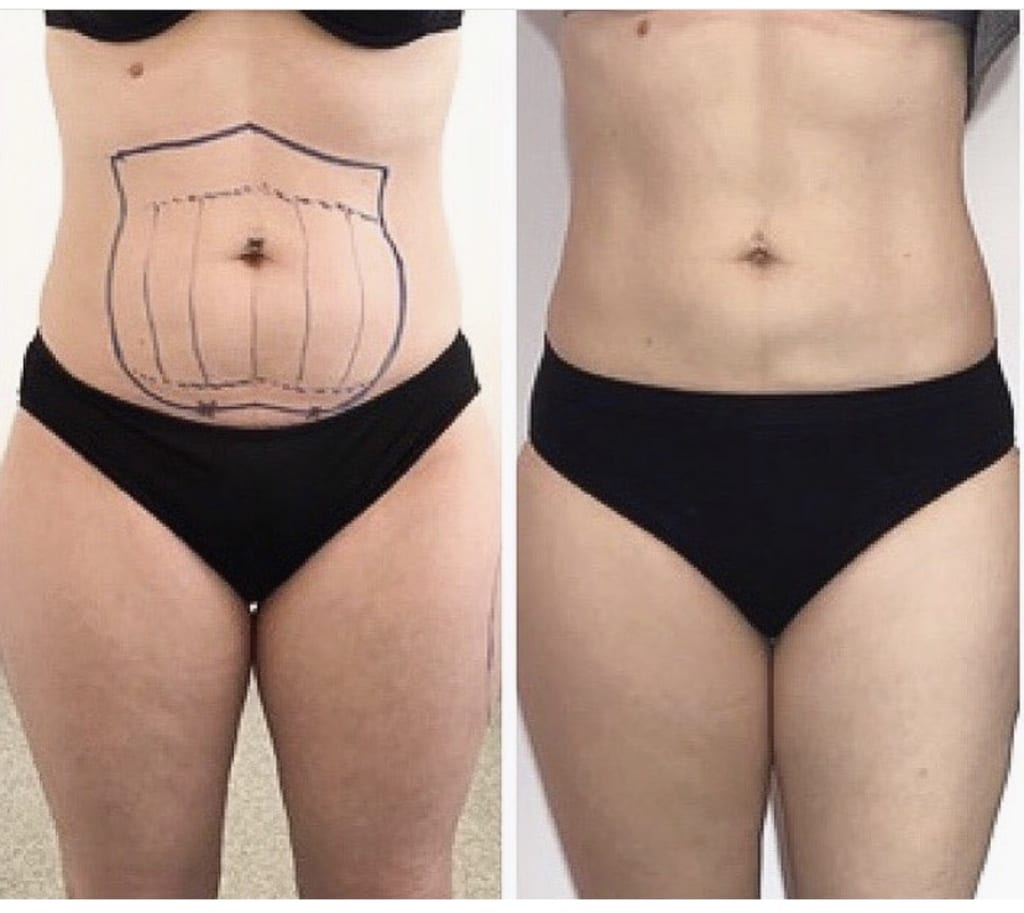Liposuction before and after
Pictures and all important tips for liposuction before and after

What is Liposuction?
Liposuction is a surgical procedure used to reshape the aesthetics of the body, eliminating by aspiration the fat deposits resistant to the slimming action of diet and exercise .
Liposuction surgery should not be considered a simple and alternative method to lose weight , but a real surgical procedure to be used only when the classic cosmetic, dietary-behavioral and aesthetic medicine interventions (e.g. mesotherapy ) they did not produce the expected results in terms of reduction of localized adiposity , the perception or extent of which is such as to compromise the harmony of the silhouette and interfere with the person's self-esteem and quality of life.
In addition to the traditional technique, several procedures have been developed over the course of many years to perform liposuction .
The general principle consists in the insertion under the skin of a thin cannula connected to a suction device, which - through appropriate maneuvers by the surgeon - shatters the fat pads. When the suction is activated, small pieces of subcutaneous tissue containing adipocytes , blood , lymph , amorphous substance and other cells are aspirated and removed . Once the desired result has been achieved, the treated area is bandaged to promote tissue remodeling. Liposuction can be performed on specific areas of the body, such as the abdomen , thighs, knees , arms or buttocks. Although the surgery is most commonly used for aesthetic body contouring, it can also be applied to reduce breast size in men ( gynecomastia ) or to remove lipomas (benign fat tumor ).
The technique is commonly believed to be effective, safe and easy to apply. In fact, liposuction is especially suitable for people with a stable body weight , with mild or moderate overweight , who have a couple of limited and problematic points. In fact, liposuction is not a treatment for obesity, but a body remodeling procedure: in cases of severe overweight it is more useful to follow a balanced diet and practice regular exercise , or to evaluate any bariatric surgery procedures , such as gastric bypass .
Several factors limit the amount of fat that can be safely removed during a single liposuction session. The removal of very large volumes (more than 5 liters) is a complex and potentially life-threatening procedure. The safety of the technique depends not only on the amount of tissue removed, but also on the choice of anesthetic and the general health condition of the patient. The potential risks of liposuction and expectations about obtainable cosmetic results should always be discussed with your doctor before undergoing the surgery. Finally, over time, the adipose tissue can repopulate and the number of adipocytes can be restored. The only way to ensure that the adipose tissue removed during liposuction will not return to its place is tobalanced diet and adequate exercise.
The first goal of any liposuction procedure is to remove the right amount of fat while causing minimal discomfort for the patient.
Liposuction reduces the accumulation of fat in a specific area of the body, such as:
Abdomen;
Arm;
Buttocks;
Calves , ankles and knees;
Breast and back ;
Flanks;
External and internal thighs;
Neck and chin.
Liposuction is also used for the reduction of gynecomastia (i.e. the development of fatty tissue in the male breast) and to treat certain medical conditions, including:
Lipomas (benign tumor of adipose tissue);
Lipodystrophy (abnormality of adipose tissue, with redistribution of lipids in the body);
Hyperhidrosis (excessive sweating), to remove the sweat glands from the underarm area .
Liposuction criteria and considerations
After surgery, the skin must spontaneously remodel around the new contours. The surgeon must therefore evaluate the elasticity of the skin in advance, also in relation to the quantity of fat to be removed. If you have good skin tone , the procedure improves the profile and proportion of the body. On the other hand, if the treated area has a thin skin surface with poor elasticity (as in elderly people), the skin, after liposuction, may appear loose, since it has a limited ability to adapt readily to the new shape.
Not all individuals are good candidates for liposuction. Ideal patients are physically active, with a stable body weight (which differs little from the ideal one) and with good skin tone and elasticity. To undergo liposuction, you must be in good health, with no conditions that could complicate the surgery (infections, heart or circulation problems , bleeding disorders , diabetes, or a weak immune system ). Liposuction is not recommended for people on medication that can interfere with blood clotting (such as aspirin , warfarin, and heparin).
The remodeling of body shapes, following liposuction, is generally long-lasting, as long as the weight remains stable. If a person gains weight after a liposuction procedure, the distribution of fat may change (for example, if the abdomen has been treated, the new fat accumulations may predominantly affect the thighs or buttocks, making them problem areas).
Liposuction does not improve the imperfections of cellulite or other irregularities of the skin surface. Likewise, the liposuction remodeling procedure does not remove stretch marks .
Some areas of the body respond better to liposuction, and the procedure can have varying outcomes from person to person. The density of adipose tissue, in fact, varies subjectively and according to the body site.
Preparation
Before proceeding with liposuction, the patient must undergo a complete physical examination (including blood tests ), during which the state of health (both physical and psychological), the elasticity of the skin and the position of the pads are assessed. adipose. If the doctor decides that the subject is an acceptable candidate for liposuction, a pre-procedure consultation begins in which the details of the surgery are defined: which area exactly will be treated, which procedure is most suitable, what to expect during and after liposuction, what results can be obtained and the possible associated risks. The tobacco smoke should be avoided for about two months before the surgery, since nicotineit interferes with circulation and can cause loss of tissue elasticity. Some pain relievers , such as aspirin and some non-steroidal anti-inflammatory drugs (such as ibuprofen or naproxen ), should be stopped for at least seven days before surgery. Your doctor may prescribe an antibiotic to be taken before and after surgery to prevent infections.
How to do it
Liposuction procedures differ in some details; the ways in which they are performed depend on the specific technique, but there are some principles common to all liposuction methods. On the day of surgery, while the patient is in an upright position, the doctor with a pen will mark circles and lines on the target areas, to mark the insertion sites and the adiposities to be aspirated. Some photos may also be taken, to compare images before and after liposuction. In the operating room, a sterilizing solution (for example, povidone- based ) is applied to the affected areas. A local anesthetic is then administered, limited to the specific area of the body and the insertion sites, or general (induces a temporary state of unconsciousness).
In most cases, the first phase involves injecting a wetting solution into the area to be treated, consisting of physiological saline, epinephrine (to reduce bleeding) and a local anesthetic (to temporarily minimize pain both during and after the surgery). The surgeon proceeds by making a small incision (or more incisions) in the area, through which he inserts a thin cannula connected to a vacuum pump by means of a flexible tube. By rapidly manipulating the cannula back and forth, the surgeon can separate and remove excess fat cells ; during the various phases the doctor repeatedly checks the quantity of liquid and fatwhich are aspirated and collected; meanwhile, if the patient is alert, he only feels a scraping sensation caused by the movement of the cannula.
The surgical team will monitor your heart rate , blood pressure, and blood oxygen level throughout the procedure. Overall, the surgery can last anywhere from one to 4 hours, depending on how much fat is removed, the removal technique and the number of sites that are aspirated until the desired result is achieved.
After the procedure - to help drain fluid from the liposuction site - the surgeon may leave the incisions open or apply a couple of sutures. In some cases, the doctor may insert a drainage tube. Patients should be aware that post-op may experience pinkish fluid leaks through the cannula insertion holes for approximately 24 hours. This process is normal and helps minimize bruising . However, during drainage, dressings should be changed on a regular basis. After about three days, applying a few self-adhesive bandages is sufficient.
The fat-deprived tissue layers collapsed during healing will create the new body shape. For this reason, after liposuction, the patient must wear a compression garment.
Recovery and results
Recovery is quite rapid and can vary based on factors such as the volume of fat cells removed and the area subjected to liposuction. The patient can be discharged the same day in case of local anesthesia or be hospitalized for at least one night, at the medical facility or hospital. Spending a few hours in clinical observation allows medical staff to monitor the patient's post-operative recovery. The sutures at the incision sites are removed after about 10 days, and minimal scars may remain where the doctor has cut into the skin to insert the cannula. Walking just after surgery can help prevent blood clots from formingin the legs. After liposuction, many patients experience pain, numbness, tingling, or burning during the recovery process, but these symptoms usually go away within six to eight weeks. After liposuction, swelling and bruising may also appear, which can take anywhere from 4-6 weeks to six months to fade and disappear. The surgeon may prescribe analgesics to help control pain and antibiotics to reduce the risk of infection. Additionally, you may need to wear special supportive clothing, which compresses the affected area to reduce swelling and aid in the remodeling and healing process. the compression sleeve must therefore be elastic and allow the use of dressings.
The final result of the liposuction will be evident within a couple of weeks, although it takes a few months for the swelling to disappear, making the cosmetic improvements produced by the surgery visible. Depending on the extent of the liposuction, it may take a few days before returning to work and up to a couple of weeks before resuming normal activities, including exercise. In some cases, the patient can return to work within 24-72 hours after the procedure. The results of liposuction are generally long-lasting, as long as it is possible to keep the body weight stable over time; however, it is important to understand that liposuction will in no way prevent you from gaining weight. To maintain the new shape obtained with liposuction, it is therefore necessary to follow a balanced diet , combined with regular exercise.
About the Creator
Garcia bablo
Here you can see all types of tattoos like Mermaid Tummy Tuck Tattoo, Roses and Heart Tummy Tuck Tattoo, Crown Tummy Tuck Tattoo, Whimsical Blossom Tummy Tuck Tattoo, "tummy tuck tattoo" Large Rose Tummy Tuck Tattoo.
Enjoyed the story? Support the Creator.
Subscribe for free to receive all their stories in your feed. You could also pledge your support or give them a one-off tip, letting them know you appreciate their work.






Comments
There are no comments for this story
Be the first to respond and start the conversation.